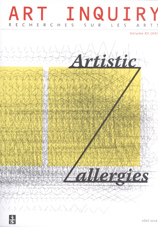The trauma of sense. The Declarations, Manifestations and Institutions of Andrzej Partum
The trauma of sense. The Declarations, Manifestations and Institutions of Andrzej Partum
Author(s): Kazimierz PiotrowskiSubject(s): Philosophy
Published by: Łódzkie Towarzystwo Naukowe
Keywords: anomaly (anomalies); error; medicalisation of allergy; trauma of sense; nihilism
Summary/Abstract: The trauma of sense is not only a trend of modernism inspired by the spirit of nihilistic culture, and especially by the impact of Nietzsche’s philosophy on modern thinking, but this condition reaches beyond the economy of modernity and the present post-human, postmodern mentality, since it also characterizes human condition. If we are searching for some more profound motives of the founding allergy in European culture, aesthetics, and art history, we cannot ignore the allergic reactions to religion, metaphysics, morals and ideology, especially in totalitarian regimes. In this study of cultural allergy I attempt to present the case of Andrzej Partum. In my opinion Partum (1938-2002) was the first accomplished nihilist in Polish culture and art. His declarations, manifestos and institutions show that he saw the 1970s as a state of increasing abnormality. It is therefore understandable that he either could not or did not want to accept this burdensome state. In Partum’s case we are dealing with the attacks on artistic criticism and institutions of art in the totalitarian society. Partum deliberately undermined all attempts to socialise art. Both his poetry and his other artistic activities should be called, in accordance with his terminology, antibodies (poetic, artistic, theoretical allergens). The point is not in being avant-garde, but in being a-social and cynical in the positive sense. The Polish art of the 1980s joined in the postmodern revaluation of nihilism. The neo-avant-garde was quite simply tired of fighting. It is not surprising therefore that Partum reached in 1980–82 for the nihilist economics of relaxation, similarly to postmodern philosophy. Partum’s positive nihilism of art – an anomaly in relation to the ordinary understanding of the term – was not an attempt at negation, but rather an attempt at provoking the pathological decay of one of the concepts of the Great Avant-garde which Renato Poggioli called radical and totalitarian, integral and metaphysical nihilism. The difference between modernist nihilism and Partum’s positive nihilism is the difference between repressive nihilism and ironic nihilism, as it desires to degenerate into comic nihilism. Partum’s positive nihilism is important for our study of allergy in culture, because it implies an ironic agreement to the irreducibility of anomalies, a tension which we experience when we face a conflict between the “abnormal” context of art and the “normal” context of theory, between art and religion, morals, politics, science or ideology. Partum’s allergy is not an example of an obscure natural disease, but it is a symptom of social relations. His allergic reactions to all sense, like other socially constructed disturbances (for example hysteria, anorexia or agoraphobia), are from an etiological point of view a disease of dependence, of social subordination.
Journal: Art Inquiry
- Issue Year: 2010
- Issue No: 12
- Page Range: 143-168
- Page Count: 26
- Language: English

